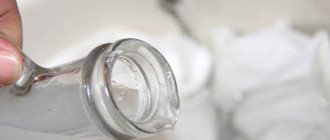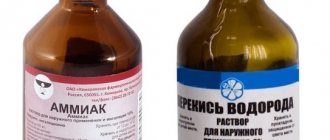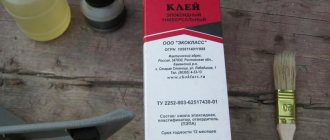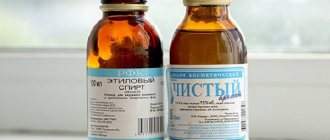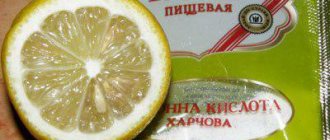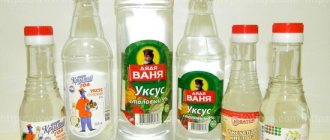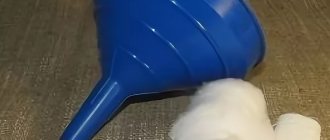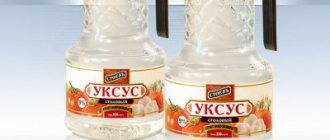What is ammonia, ammonia and ammonia: name, formula, composition
A solution of ammonia has the formula NH4OH. It is liquid and transparent. Its distinguishing feature is a strong pungent odor.
Ammonia formula
The product is not used in large quantities because it is dangerous. But a small dose can have a stimulating or irritating effect. The main area of use of alcohol is medicine.
It allows you to revive a person if he faints. It is also used by surgeons. They use it to clean their hands before surgery. The product also performs well for cosmetic purposes.
Ammonia consists of a 10% ammonia solution, but don’t think that it’s the same thing. Ammonia is a different substance and is primarily a gas.
Ammonia formula
It becomes liquid at a temperature of -33 degrees. But this is only done not with the help of water, but in a slightly different way. If you simply add water to ammonia, it will have no effect.
The methods for obtaining substances are different. Moreover, one comes from the other.
Final table
And for ease of understanding how the materials considered differ, we offer a summary table:
| Substance | State | Chemical compound | Formula | Application | Properties |
| Ammonia | Gas | Hydrogen nitride | NH3 | Industry, fertilizers | No color. Strong smell. |
| Ammonia | Liquid | Ammonium hydroxide | NH4OH | Medicine, fertilizers | No color. Strong smell. |
| Ammonia | Solid | Ammonium chloride | NH4Cl | Fertilizers, food additive, flux | Odorless powder, white |
What is the difference between ammonia and ammonia, ammonia: differences
A solution of ammonia, as we have already said, is obtained from ammonia. Although it was created for the purpose of use in medicine, it is also widely used in everyday life. Why is it important to know this?
First of all, ammonia is often sold in concentrated form. An aqueous solution of 25% and higher is made from it. It is strictly forbidden to use such a product in everyday life, because there is always an accumulation of gas above the surface of the solution, which is almost two times lighter than air.
Ammonia
When heated, ammonium hydrate decomposes. This can lead to the fact that when a container with a substance is opened, a “gas cushion” can escape. Therefore, even if a person faints, one should not immediately give the medicine a sniff from the bottle. Better wet the napkin. If you do not adhere to this recommendation, then instead of increasing breathing, it may stop.
Moreover, concentrated ammonia is very caustic. It can damage not only the mucous membranes, but also the skin. The solution can leak through the latter and even through household rubber gloves and poison the body.
Even if you dilute the substance with alcohol yourself, negative consequences may occur. Concentrated solutions contain many hazardous impurities for human health.
The last argument is the difference in the formulas of both substances. Ammonia has the formula NH3, and ammonia has the formula NH4OH.
Precautionary measures
It is necessary to exercise extreme caution when using the product and not to ignore personal protective equipment. The safety of using ammonia will largely depend on following the simplest rules:
- Ammonia hydroxide should be diluted in air or in a well-ventilated area;
- you need to avoid getting ammonia on your facial skin;
- store the drug in a locked place and out of reach of children;
- inhaling ammonia vapor is prohibited for people who suffer from vegetative-vascular dystonia;
- Do not mix alcohol with other substances.
When using ammonia as a fertilizer and plant food, you should use rubber gloves and a special protective mask. If for any reason undissolved ammonia hydroxide gets ingested, you should drink a large amount of water, induce vomiting, and then consult a doctor for help.
How to dilute ammonia to obtain ammonia: proportions, percentages
As we have already said, it is not recommended to prepare a solution of ammonia. Yet there is a way to do it. Typically, this product is used in everyday life to get rid of insects or eliminate unpleasant odors in the kitchen. To do this, mix 1 part ammonia with 9 parts water. In percentage terms, it looks like this - 10% alcohol and 90% water.
A more complex method is somewhat reminiscent of preparing medical alcohol. The only difference is in the number of components.
How to make ammonia yourself?
The substance is prepared from vodka. But it’s not enough to just buy it and freeze it. This will not give the desired result, and therefore you will need a moonshine still. Of course, after using it you will get something stronger than vodka, but still not pure alcohol. To obtain it, distillation of vodka is required.
For this you will need:
- Confectionery yeast
- Simple package
- Glass jar
You should have everything at your fingertips. So, the preparation will be as follows:
- Pour the juice or fruit drink you prepared into a glass jar
- Add yeast to it. Expect that 30 g of yeast is added per 1.5 liters of drink
- Mix the mixture well and close the lid.
- Place the closed jar on the battery
- Open it every day to allow carbon dioxide to escape. If you don’t do this, then don’t be surprised that your jar explodes
- Do this for several days until the alcohol is released. The longer you keep the jar, the more alcohol will be released.
- After some time, the mixture will harden and the alcohol can be drained off.
To make sure that you definitely have ammonia, pour a little liquid into a tablespoon and try to heat it from below. It should flare up.
History of ammonia
Ammonia was first discovered in 1774 by the English chemist Joseph Priestley.
The gas he discovered was called “alkaline air”, since the chemist, and at the same time the priest, could not determine the chemical composition. Only 11 years later (in 1785) Claude Louis Berthollet, a famous French chemist, determined the chemical composition of the gas and named it ammonia (NH3). There are two versions as to why the gas was named this way:
- one is associated with the name of the god of the ancient Egyptians - Amon;
- the second - with a similar-sounding oasis in the region of northern Africa - “Ammon”.
According to the first version, people who worshiped the god Amon sniffed ammonia during the ritual.
According to the second, in the oasis of Ammon, which is located at the crossroads of caravan routes, due to the presence of a huge number of pack animals, their waste products accumulated. In hot climates, urea tends to quickly decompose and release a gas called ammonia.
Which of the two versions is reliable and correct is unknown to this day.
Ammonia, ammonia, ammonia: use in medicine and everyday life
Using ammonia
A lot of questions arise about how to use ammonia solution, or more precisely, for what purpose can this be done?
So, there are several areas where ammonia is used.
- At home
Ammonia water effectively removes stains from any surface. For example, you want to remove a stain on your favorite T-shirt. Then add 2 tablespoons of ammonia to a glass of water and soak the stain for a couple of minutes. After this, you can rinse the item. If you are afraid that the smell will remain, then in vain, because there is no smell left after ammonia.
By the way, cockroaches are very afraid of this product. When you wash the floor, add a little ammonia to a bucket of water. Add 1 teaspoon per 1 liter. Cockroaches really don’t like the pungent smell and they leave. It is recommended to do the procedure every week, even for prevention. Mosquitoes and midges do not like ammonia either. All you have to do is spray the solution around yourself and the insects won’t even come close.
This product also helps clean plumbing fixtures, silver or gold items. You need to mix water, tooth powder and ammonia. The ratio will be 5:2:1. After this, take soft gauze and moisten it with the solution. Wipe the desired item and rinse it well with water.
- For indoor plants
Houseplants Houseplants
need oxygen and nutrition. Ammonia copes well with both tasks, and it also protects flowers from pests. Dilute a large spoonful of the product in three liters of water and you will get an excellent feeding. Just water your flowers with this water and they will grow actively.
If you have problems with aphids, then take the flowers out to the balcony and spray them. The solution is also prepared from three liters of water, but three tablespoons of ammonia and two drops of shampoo are added to it.
- In the garden
For the dacha, ammonia is also indispensable. It is used for preventive treatment of trees, shrubs and berries. Top dressing is prepared from 4 liters of water and 50 ml of solution. You can water the plants in this way until the end of June from planting. This solution repels pests.
- For acne
Ammonia works great for acne on oily skin. It is used for washing. The solution is very simple - half a teaspoon per glass of warm water. Moreover, you can wipe problem areas separately with a cotton swab.
- In medicine
As you know, ammonia is used to bring a person to his senses after fainting. At the same time, it removes acne well, helps with poisoning, and against insect bites. This alcohol can even help with joint pain and hangover. Of course, its scope of use is much wider and there are many other diseases that this remedy helps to treat.
The solution is also widely used in cosmetology. If you mix it with glycerin, you get an ideal remedy for dry skin on your feet and hands. The lotion eliminates cracks and softens the skin. Ammonia also has a good effect on hair if you use it as a rinse. To do this, dissolve a teaspoon of alcohol in a glass of warm water.
The role of ammonium hydroxide in biological systems
This substance is an important source of nitrogen for living systems. Nitrogen is a chemical element necessary for the biosynthesis of amino acids. Ammonium hydroxide is used in industry to produce nitrogenous fertilizers necessary for the normal growth and development of agricultural crops.
In human and animal tissues, a significant amount of amino acids is formed due to metabolism. High concentrations of ammonia in tissues are toxic to the body. The liver converts ammonium hydroxide into a product less toxic to the body - urea. Diseases that result in liver dysfunction (hepatitis, liver cirrhosis, cholecystitis) can lead to an increase in the concentration of the above substance in the blood (hyperammonemia). Ammonia hydroxide takes part in the regulation of acid-base balance in the body.
Symptoms of poisoning
Below are a number of signs of ammonia poisoning:
- Severe cough, difficulty breathing.
- Burning in the eyes, tearing, painful reaction to bright light.
- Burning in the mouth and nasopharynx.
- Dizziness, headache.
- Abdominal pain, vomiting.
- Reduced hearing threshold.
- With more serious poisoning, the following are possible: loss of consciousness, convulsions, respiratory arrest, acute heart failure. The combination of violations can lead the victim to a coma.
Methods of obtaining
About 100 million tons of ammonia are produced annually in the world, so this process can rightfully be considered one of the most important in the world. It is produced in liquid form or as a twenty-five percent solution.
There are the following ways to obtain it:
1. In industry, ammonia is produced through the synthesis of nitrogen and hydrogen, which is accompanied by the release of heat. Moreover, this reaction can only take place at high temperature, pressure and in the presence of a catalyst, which, while accelerating a weak reaction, does not itself enter into it.
Ammonia reaction equation:
N2 + 3H2 ⇄ 2NH3 + Q
2. Ammonia can be obtained during the coking of coal.
In fact, coal does not contain any ammonia, but it contains many organic compounds, which contain nitrogen and hydrogen. And when coal is heated strongly (pyrolysis), these components form ammonia, which comes out as a by-product.
3. In the laboratory, ammonia is produced by heating ammonium chloride and calcium hydroxide:
2NH4Cl + Ca(OH)2 → CaCl2 + 2NH3↑ + 2H2O
4. Or by heating ammonium chloride with concentrated alkali:
NH4Cl + NaOH = NaCl + NH3↑ + H2O
Prevention in case of poisoning
First aid in this case consists of several simple steps. First, you need to take the victim out into the fresh air and wash his face and eyes with running water. Even those who were not very good at chemistry know from school: alkali is neutralized by acid, so the mouth and nose must be rinsed with water with the addition of lemon juice or vinegar.
If the poisoned person has lost consciousness, you should lay him on his side in case of vomiting, and if his pulse and breathing stop, give him a cardiac massage and artificial respiration.
Physical properties
Here are the physical properties of ammonia:
- Under normal conditions it is a gas.
- Colorless.
- Has a pungent odor.
- Poisonous and very toxic.
- Very soluble in water (one volume of water per seven hundred volumes of ammonia) and a number of organic substances.
- The melting point is -80 °C.
- Boiling point is about -36 °C.
- It is explosive and flammable.
- About half as light as air.
- It has a molecular crystal lattice, therefore it is fusible and fragile.
- The molar mass of ammonia is 17 grams/mol.
- When heated in an oxygen environment, it decomposes into water and nitrogen.
